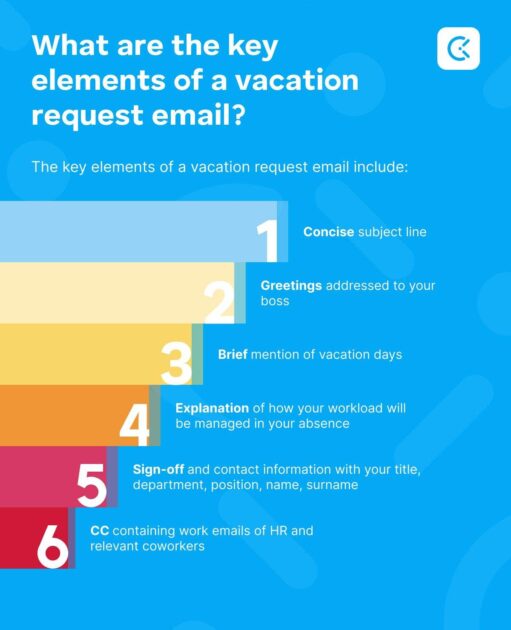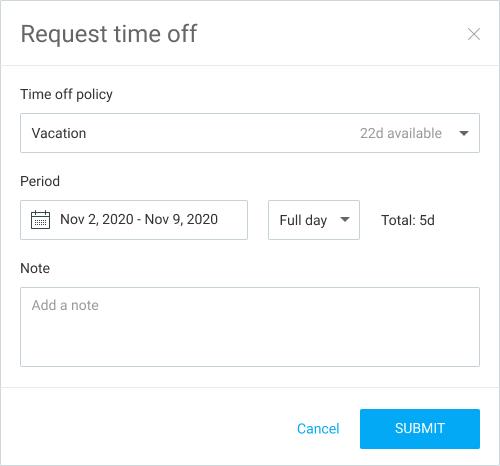Before you book your next vacation, don’t forget to ask your boss!
Duh — you might say.
But some employees face difficulties formally asking their superiors for vacation days.
So, this article lays out samples, examples, and tips on how to:
- Write a vacation request email,
- Get straight to the point in your correspondence, and
- Maintain a professional tone in your leave of absence letter.
Let’s get into it.

- A vacation request email is a written request for leave of absence that employees address to their boss or manager.
- The key elements of a professional vacation request include a concise subject line, greeting, mention of vacation days, CCing HR, stating who’ll take over your workload while you’re away, and a sign-off.
- To make your vacation request email more likely to get approved, maintain a professional tone, get straight to the point, and use the most appropriate sample of a vacation request email.
- A vacation request isn’t confined to a day or week. Depending on your company’s policies, you can ask for a half-day off or a longer vacation spanning several months.
Table of Contents
What is a vacation request email?
A vacation request email is a formal, written request for leave sent to your boss, supervisor, or manager via your work email. Depending on your company’s policy, you need to send your leave request email days or weeks before the time you want to take off.
Similarly, company policy dictates whether the employer will ask the employee to mention the reason for their vacation, like visiting friends or relatives — or some other reason.
Request a vacation with Clockify
In the following sections, we’ll give you all the samples, examples, steps, and tips to be convincing in your next time off request email.
Because, remember that your boss is more likely to accept your request for leave if you’ve written it in a way that makes it easy to say yes and difficult to say no.
💡 Clockify Pro Tip
On a similar note, learning to say “no” to your boss is one of the most critical skills at work, but few ever master it. Explore the do’s and don’ts of saying no to others in the workplace in this blog post:
What are the key elements of a vacation request email?

The key elements of a vacation request email include:
- Concise subject line,
- Greetings addressed to your boss,
- Brief mention of vacation days,
- Explanation of how your workload will be managed in your absence,
- Sign-off and contact information with your title, department, position, name, surname, or other relevant details, and
- CC containing work emails of HR and relevant coworkers.
As long as you cover these aspects, your vacation request email will be on point.
How to write a vacation request email
Writing to request time off is a skill we need to master sooner or later.
But not every company has the same approach to writing a vacation request.
The upcoming sections offer a step-by-step guide on compiling your next vacation request email.
💡 Clockify Pro Tip
To show your boss how much effort you put into your work, send them an email with your biggest achievements. Learn how to do that in our detailed guide:
Step #1: Write a concise subject line
You want your email to stand out in your boss’s inbox. So, make your subject line as concise as possible.
For illustration, you can try some of the following samples:
- Time Off Request — [Vacation request dates + your name],
- Annual Leave Request — [Vacation request dates + your name], or
- Vacation Request — [Vacation request dates + your name].
If you have a more formal relationship with your boss, we advise inserting your name and surname into the subject line.
In any case, a wordy or vague leave request may result in your boss skipping it, so be wary!
Step #2: Greet your boss properly
As soon as you finish your concise subject line, you should greet your boss respectfully.
In this case, be either formal or informal — but make it simple, like in the following examples:
- “Dear [Manager’s name]” — for a more professional greeting, or
- “Hey [Manager’s name]” — for a more informal greeting.
Anyway, don’t linger on this part too much. As long as you know your manager’s name, you’re off to a great start!
After that, you can express common courtesy in a few words, like:
- “I hope you’re doing great,”
- “I hope this email finds you well,”
- “How are you doing?”,
- “Good afternoon” or similar expressions.
However, phrasing this how-you-doing part depends on your email type (more on that in a bit).
Step #3: Mention your vacation days
To keep your employer in the loop, mention your vacation days in the next sentence of your vacation request email after the greeting part.
Here are a few tried-and-tested examples:
- “I would like to take [Vacation request dates] off.”
- “I want to have my yearly vacation on [Vacation request dates].”
- “I’d like to request leave for the following dates: [Vacation request dates].”
As long as your professional email contains the actual dates you want to take off, you’re nearing the end of your vacation request email.
💡 Clockify Pro Tip
We don’t recommend working during the holidays, but if you have to, here are 12 great pieces of advice to lift your spirits:
Step #4: State who’ll take up your workload while you’re away
For longer vacation request emails or urgent ones, you should explain in a sentence or two how your workload will be managed in your absence. This shows you’re committed to your job and want to keep things running smoothly.
Here are a few examples of how to do just that:
- “I’d like to let you know that [Coworker’s name and surname] will take up a portion of my workload while I’m away, so our customers won’t feel a decline in services.”
- “Please be informed that all my current tasks have been rescheduled until my leave ends and I will continue working on them once I’m back to work.”
- “[Coworker’s name and surname] will handle a few of my tasks while I’m on leave.”
Usually, you won’t be required to explain the reason for your time off. Yet, if you’re requesting the vacation just a day or two upfront, you may want to let your manager know why, as it could impact whether your request gets approved.
💡 Clockify Pro Tip
After you come back from your time off, get 15 awesome tips to improve work performance and impress your boss:
Step #5: Sign off professionally
As with all things work, be respectful toward your boss when sending your vacation request email.
Here are a few ways you can end your email:
- “Thanks for considering my request. [Your name, surname, and phone number]” — for a more formal email, or
- “Talk to you soon [Your name and phone number]” — for a less formal email.
You should always leave your phone number in case your manager wants to contact you directly regarding your vacation request email.
Step #6: Put HR (and other relevant coworkers) in CC
Last but not least, make things as transparent as possible by informing your HR department about your request. That way, even if your boss misses your email or something else goes awry, you still have the email to show you requested your leave on time.
We recommend CCing your most senior HR specialist or other relevant personnel you should keep in the loop on your vacation leave.
But don’t forget to include their work emails, not personal ones. You may know some of them personally, so you could easily mix up their work and personal email addresses.
Ultimately, CCing is the best practice when your email concerns others.
Request a vacation with Clockify
Vacation request email samples and examples
To glue all this information together, we’ll look at 9 examples and samples of professional vacation requests, coupled with fresh expert advice.
Example #1: Simple vacation request email
A simple vacation request email is just what it sounds like. It conveys your request quickly and simply, in no more than 4 sentences.
Here’s an example of this type of email:
Subject line: Vacation request — [Vacation request dates and your name]
Dear [Manager’s name],
I would like to take [Vacation request dates] off. I’ve arranged for my coworkers to take part of my workload while I’m away.
All the best,
[Your name and phone number]
Human Resources Director at The TemPositions Group of Companies, Sally Ahmed, describes the cornerstone of a simple vacation request email, including the title, greeting, and reasoning:

“Greet your manager as you normally would, and provide the dates you’re requesting. It’s also important to note what professional preparations you’ve made before the trip and who else on your team is available to help in your absence.”
💡 Clockify Pro Tip
Get more than 50 bolts of inspiration to achieve better results at work:
Example #2: Informal vacation request email
If you and your boss are close because you have worked together for years, an informal vacation request email might work best.
Here’s an example of an informal email of this type:
Subject line: Vacation request for [Vacation request dates]
Hey [Manager’s name],
I want to take some time off on [Vacation request dates]. Can you approve these dates? I plan to book my flight in the next day or two.
Thanks, and talk soon,
[Your name and phone number]
CEO of Z Branding, Kraig Kleeman, says that you should have a laid-back tone to your informal vacation request emails:

“Inject some personality into your request. Briefly share your plans, making it like a casual conversation with a friend. Don’t forget to toss the dates, maintaining a relaxed and friendly tone.”
Example #3: Formal vacation request email
If you don’t know your boss well, or your company encourages formal emails, write a formal vacation request email.
Here’s an example of this type of email:
Subject line: Vacation leave request — [Vacation request dates and your name, Surname]
Dear [Manager’s name],
Could you please consider the following date for my leave: [Vacation request dates]?
I have not made any arrangements regarding my vacation and will wait for your approval first.
Yours sincerely,
[Your name, surname and phone number]
Sally Ahmed believes that a formal vacation request email should be more official than other types:

“Maintain a professional tone that’s straight to the point as you outline your requested days. Include a respectful sign-off and invite your manager to follow up with any additional questions.”
Example #4: Vacation leave request email
The vacation leave request email blends the previous two types of requests — informal and formal.
Here’s how you might go about it:
Subject line: Vacation leave request — [Vacation request dates and your name]
Hi, [Manager’s name],
I’m planning to book a holiday out of town, so I wondered if you could approve [Vacation request dates] as days off for me?
I hope you’ll approve my request so that I can book my holiday soon.
Talk to you soon,
[Your name and phone number]
Rule of thumb: The tone in your leave of absence request letter depends on your boss’s approachability and how well you two get along, so remember to take that into consideration when crafting your email.
💡 Clockify Pro Tip
Get tips on how to request time off in our guide:
Example #5: PTO request email
PTO and vacation aren’t the same, so you may want to write a PTO request email instead of a vacation request email at some point. In short, PTO stands for paid time off — a leave that’s paid for by the employer. In contrast, a vacation can sometimes be unpaid.
Here’s what this time off request email looks like in action:
Subject line: PTO request — [Request dates and your name]
Dear [Manager’s name],
I want to use part of my paid time off during [Request dates]. I have checked with HR and our PTO policies, so it seems I’m eligible for this PTO.
Of course, I will make sure that all my work is completed or assigned to other coworkers before the requested period.
Thank you, and all the best,
[Your name and phone number]
Kraig Kleeman speaks to the importance of following organizational policies when it comes to PTO request emails:

“Navigate the company’s PTO policies seamlessly. Clearly express your PTO request, including dates and any pertinent details. Compliance is crucial here, ensuring your time off aligns with organizational guidelines.”
💡 Clockify Pro Tip
Learn the difference between paid time off and vacation in this article:
Example #6: Day off request email
Sometimes, you just need a day to relax, take care of some errands, or address an emergency. In other words, some companies allow for personal days — but check with your HR or manager just in case.
In many instances, however, an email request for a day off is your best bet.
Here’s a sample of a day off request email:
Subject line: Day off request — [Vacation request date and your name]
Hi, [Manager’s name],
I would like to request a day off on [Vacation request date].
I’ve talked to my coworkers, and they will cover for me on the said date.
Can you please approve my request?
Many thanks,
[Your name and phone number]
In any case, check your company policy to see how many days in advance you need to request time off. For example, some organizations don’t allow last-minute requests.
Request a vacation with Clockify
Example #7: Longer vacation request email
At other times, a day or week off doesn’t cut it. This is where a longer vacation request email can help.
When you ask for an extended vacation, it’s helpful to provide reasons behind your request to increase the chances of your vacation time being approved.
Here’s how to go about it:
Subject line: Longer vacation request — [Vacation request dates and your name]
Hi, [Manager’s name],
I would like to take an extended leave on [Vacation request dates] due to [Reasons].
I understand that you will need time to consider my request, as my time off during the said period could impact my work duties.
Yet, I assure you that I will take care of all my tasks before my time off and ask my colleagues to take up a chunk of my workload while I’m away.
I would like to propose that we meet at the office and discuss the matter in more detail.
I look forward to talking with you,
[Your name, surname, and phone number]
Longer vacation request emails are rare but sometimes necessary. Kraig Kleeman says that you should address whether your vacation days can impact your work and how to make things easier for everyone involved:

“Elevate your communication for an extended break. Share the excitement with a detailed itinerary, highlight extended dates, and transparently discuss any potential work impact. Assure your team of a smooth transition, fostering understanding and collaboration.”
💡 Clockify Pro Tip
Speaking of teamwork, get 10 tips on how to create good team vibes in your office crew:
Example #8: Vacation reminder email
The vacation reminder email serves to remind your supervisor about the vacation they’ve already approved.
Here’s an example of a vacation reminder email:
Subject line: Reminder — [Your surname] vacation for [Vacation request dates]
Dear [Manager’s name],
I wanted to remind you that, in line with our conversation [Time when you had the conversation, roughly], I will be taking my time off on [Vacation request dates].
As we discussed, my coworkers [Name and surname of coworkers] will work on my project while I’m on vacation.
All the best,
[Your name, surname, and phone number]
Depending on how busy they are, your manager may forget that they’ve approved your time off. Just to be sure, send a vacation reminder a few days before your approved vacation starts.
💡 Clockify Pro Tip
Struggling with absenteeism? Check out our blog to learn about the causes and costs of absenteeism in the workplace:
Example #9: Carryover vacation days request
Some employers allow their employees to carry over their unused vacation days from the current year into the coming year.
In this case, you’ll need to write a carryover vacation days request — and here’s a simple sample you can use:
Subject line: Carryover vacation days request — [Your name and surname]
Hi, [Manager’s name],
I hope you’re doing well. I’m writing to tell you that I have [Number of unused vacation days] from the current year that I’d like to carry over into the following year.
Please let me know if that’s possible. Of course, I’m happy to agree on the dates most suitable for you and the company once I decide to take that time off next year.
Cheers and thanks in advance,
[Your name and phone number]
💡 Clockify Pro Tip
Learn how to deduct vacation days and calculate your work days in any given year:
Emails requesting to reschedule an approved vacation
Plans don’t always work out as we would like them to.
So, sometimes you’ll need to reschedule your vacation — and this segment will teach you how to do that with samples you can use now.
Requesting a reschedule because of personal plans changing
If your plans have changed due to personal reasons, you can use this time off request email sample to reschedule your vacation leave:
Subject line: Request to reschedule approved leave due to personal reasons — [Your name and surname]
Dear [Manager’s name],
I hope this email finds you in good spirits.
I quickly want to let you know that my personal circumstances have changed and that I would like to reschedule my approved vacation for [Approved vacation dates].
Please accept my apologies if this rescheduling may cause you any inconvenience. Also, I’m more than happy to discuss any arrangements for a smooth resuming of my work tasks for the said period.
I appreciate your understanding on this,
[Your name and surname]
Requesting a reschedule because of an urgent work commitment
If an urgent work thing pops up while you’re booking that vacation flight, it’s a good idea to communicate this with your supervisor promptly.
Here’s an example of such a reschedule request:
Subject line: Request to reschedule approved leave due to work commitments — [Your name and surname]
Dear [Manager’s name],
I hope you’re doing well. I wanted to briefly inform you about a work commitment that has interfered with my approved vacation.
Namely, the work commitment in question has forced me to reschedule my approved vacation for [Approved vacation dates].
I am truly sorry if this rescheduling may cause you inconvenience. I’m available to discuss how to resume my regular work duties during the said period.
Thank you for your understanding,
[Your name and surname]
Requesting a reschedule because of an emergency
Your apartment gets flooded due to a rusty, leaking pipe, or your child gets sick — there are endless emergencies that could make you reschedule your approved vacation leave.
To make this run smoothly, use the following reschedule email sample:
Subject line: Approved leave reschedule — Urgent [your Name and surname]
Dear [Manager’s name],
I’m writing to let you know that I’ve had an unexpected emergency. Therefore, I won’t be able to take my upcoming vacation that you approved for [Approved vacation dates].
I am very sorry if this has caused any disruption in work operations. I am more than happy to discuss arrangements to reschedule my vacation during our next conversation at the office or online.
Thank you for your support and understanding during this difficult time for me,
All the best,
[Your name]
Tips for requesting vacation time
Some people prefer to talk to their boss face-to-face when requesting a vacation. Yet, your manager may forget about your verbal request for leave, unintentionally creating trouble for you.
A safer option is to write a vacation request email. Here are a few tested expert-infused tips for crafting your email request:
- Maintain a professional tone no matter what,
- Avoid using informal language (unless you’ve known your boss for a long, long time),
- Use the leave request email most suitable for your particular situation (e.g., Day off request, PTO request, Carryover vacation request),
- Get straight to the point — don’t make too long of an introduction,
- Write a concise subject line indicating what the email is about, and
- Use your work email when sending your leave request instead of your personal email.
HR Director Sally Ahmed says that the arrangement isn’t that critical as long as you’re thoughtful to others while writing it:

“Regardless of the format, the main takeaways are to be clear, concise, and considerate about your workload while you’re away, making it super easy for your manager to wish you well while you’re out.”
💡 Clockify Pro Tip
Pick a piece of team management software to manage time better, at work and off work:
FAQs about requesting a vacation
This section covers some of the most common questions about requesting time off.
Why is writing a vacation request email important?
Writing a vacation request email is critical because it leaves a trail. Simply put, you, your boss, and the HR team will know about your written vacation leave, leaving no room for misinterpretation of whether you asked for time off.
How far in advance should I send my vacation request email?
A good rule of thumb is to check your company policy to determine how many days in advance you need to request time off. But suppose you plan to take a week off. In that case, it’s a good idea to send your vacation request 2-3 weeks before your planned vacation.
Can I send a vacation request email for a half-day off?
It depends on your company’s time off policies. Some firms allow taking a half-day off, while others don’t. So, a good idea is to check with your HR or boss.
Request a vacation with Clockify
What if my vacation request email is denied?
Your boss may deny you vacation days due to busy periods. If you feel your boss has wronged you, you can escalate the issue to HR. But if you didn’t get your vacation request email in on time, perhaps it’s your fault that your manager didn’t accept your request. In the case of the latter, simply wait for another opportunity for vacation leave and ship it out timely.
How to make a vacation request with Clockify
To get your vacation spirits up and ensure your time off goes as planned, you can use a PTO and vacation tracker like Clockify.
To request leave in Clockify, you just need to:
- Mark whether you’re taking sick leave, vacation, holidays, or earned time off,
- Select the period you plan to take off,
- Add a note to your manager (optional), and
- Press Submit.
Your supervisor will instantly get an email to approve your vacation request.

You’ll receive a notification with the details as soon as your manager decides whether to approve your time off request.
This way, you and your company save a lot of back-and-forth spent on sending emails. Moreover, the Time off feature in Clockify allows you to have all your used and unused vacation days in one place.
Start tracking your paid time off and other leave requests with a time management tool.


